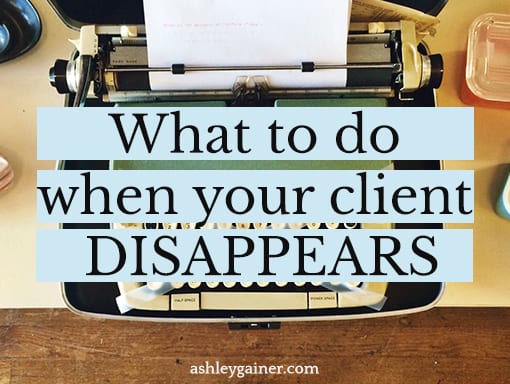Crickets…
Not what you want in your inbox when you’re waiting to hear from a client. One minute, you were trucking productively along; the next, you’re at a critical juncture with deafening silence from the other end.
So what do you do when your client disappears?
If you’re still negotiating
In the preliminary back-and-forth with a potential client and the line goes dead, you have two options: Follow up or move on. Both are good, rational options.
I send a follow-up email anywhere from four to seven days after my unanswered message. Anything earlier than four days feels a little pushy or desperate, and you do not want to be either of those things.
I send a second follow-up one week after the first, and that’s the last one — I place the ball firmly in the client’s court and then move on. Some clients use your check-in emails as their personal tickler file; saying you won’t be getting in touch anymore will initiate a sense of urgency in someone who really does want to work with you but just hasn’t gotten around to replying.
Want a template? Here you go!
Dear Client,
Thanks again for contacting me about your XYZ project. It seems you’re pretty busy right now, so this will be my last check-in. I’d love to work with you in the future, so please do get in touch when you’re ready to start.All the best,
Your Name
Also, a tip from me to you: If the client is habitually slow to respond (or is in any other way crazy-making), do yourself a favor and say you aren’t the right person for the job. That’s a red flag! Heed the warning and walk away before it’s too late.
 If you’ve already begun the project
If you’ve already begun the project
You’ve accepted the project, negotiated your terms, and started the work. Now you need some answers or feedback before you can continue, and there’s no response. In this case, you’ll need to follow up.
In general, I send my first follow-up in the Tuesday of the week after I sent the original email (meaning, the one that still needs a response). This gives the client the rest of that week plus the following Monday to work through whatever they’ve got going on.
If the week of the Tuesday message passes with no reply, it’s time to do some sleuthing. Double-check the email address you’re using against the one on the last email you received from the client. If you have (or can find) the client’s phone number, this would be a good time to call and verify that your messages were received.
If that doesn’t work, look for indications online that the person is active (for example, on social media, LinkedIn, Skype, or a blog). At this point, you can either be satisfied by knowing that the client is in fact alive and trust that you’ll get a response, or you can choose to get in touch via one of those avenues.
Be extremely cautious if you get in touch in a public forum like Twitter or a comment section — keep it neutral and professional, without even a hint of there being trouble in the water. Anyone can see what you put here, so you need to be discreet, courteous, and professional. Airing your dirty client-laundry will repel any potential clients who see it, and that’s obviously not good for business.
If you’ve done everything you can think of to reach the client and you still don’t get a response, it’s time to stop working on the project until you hear something. Send the client an email to that effect, and then put your unexpected free time to good use making magic for yourself — drafting an ebook, developing that killer course idea, or reading that business book you’ve been meaning to get to, for example.
If you’ve already done the work and it’s time to get paid
Don’t panic.
Follow up, call, and/or do some cyber-stalking… I mean, sleuthing… using the same guidelines as above. Your purpose in these messages and phone calls is to verify that they’ve received the deliverables and to discuss next steps (i.e., getting your invoice paid).
If there’s no movement, it’s time to send your invoice again (with your late fee added) through every manner possible. Email it, send it via certified mail, fax it, and call to confirm with the client that it’s been received.
Your next step is to send a late payment notice 30, 60, and/or 90 days past the invoice due date. The purpose of this notice is demanding payment (firmly but politely) and indicating your plan to take legal action. Pro tip: include a copy of the invoice with each letter.
Never sent a late payment letter? Here’s a template for your final notice:
Dear Client,
This letter is to remind you that Invoice #### for [project name] is ## days past due. This project has had an unpaid balance of $XX.xx, originally due on [date]. This is my final letter regarding this invoice.
Reluctantly, if I don’t receive payment within [anywhere from 5 business to 30 calendar] days, I’ll be left with no alternative but to take legal action.
Payment can be sent to [your payment information].
Please let me know if you have any questions. I can be reached at [email address] or [phone number]. I hope we’ll be able to resolve this matter immediately.Sincerely,
Your Name
If that doesn’t work, it’s time to look into your state’s small claims court.
And when you get paid (because you will get paid, even if it’s a hassle), brush the dust off your feet and move on. If you’re considering another project with this client, do a gut-check and then double your rates. Sign a new contract, and be sure to include the safeguards below.
If you want to prevent this from happening to you
Here are a few safeguards you can work into your contract at the front end to keep clients from going to radio silence:
- Require a nonrefundable deposit before beginning work. I require a 50-percent deposit up front for first-time clients and then 25-30 percent for subsequent work. It’s also not uncommon to require the full project fee (or estimated overall price) before beginning work.
- Explicitly state that all work on your part will cease after the client is unresponsive for a set amount of time. Add that you will invoice for any unpaid work you’ve already done at that time. (This is known as the kill fee clause.)
- Include a line about where the contract is governed (your state) and where any necessary legal action will be taken (your city’s courts). This leaves no question about jurisdiction if you end up needing to go to small claims court. It also leaves no question that you’re willing to take it there.
- Establish your ownership rights and when they’re transferred. The client obviously retains rights to any copy, photographs, graphics, and so on that they send to you. You will likely want to retain all rights to any work you do for them, to be transferred once the project is paid in full.
- That said, consider using a licensing or copyright clause to ensure your portfolio rights. In general, you will either retain the copyright (meaning you can use the work however you see fit) and license your work to the client, or you will assign the copyright to the client and retain a license to use it for your portfolio.
- Always get full contact information, especially phone numbers, even if you anticipate your communication being electronic.





